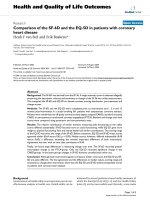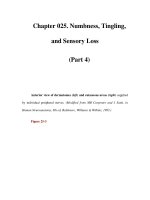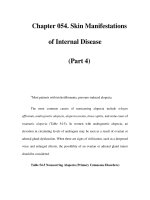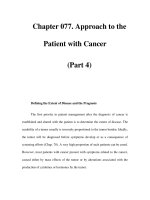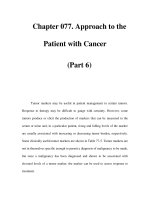Chapter 082. Infections in Patients with Cancer (Part 4) pdf
Bạn đang xem bản rút gọn của tài liệu. Xem và tải ngay bản đầy đủ của tài liệu tại đây (28.93 KB, 5 trang )
Chapter 082. Infections in
Patients with Cancer
(Part 4)
Figure 82-1
A. Papules related to Escherichia coli bacteremia in a neutropenic patient
with acute lymphocytic leukemia. B. The same lesion the following day.
Candidemia (Chap. 196) is also associated with a variety of skin conditions
and commonly presents as a maculopapular rash. Punch biopsy of the skin may be
the best method for diagnosis.
Cellulitis, an acute spreading inflammation of the skin, is most often caused
by infection with group A Streptococcus or Staphylococcus aureus, virulent
organisms normally found on the skin (Chap. 119). Although cellulitis tends to be
circumscribed in normal hosts, it may spread rapidly in neutropenic patients. A
tiny break in the skin may lead to spreading cellulitis, which is characterized by
pain and erythema; in the affected patients, signs of infection (e.g., purulence) are
often lacking. What might be a furuncle in a normal host may require amputation
because of uncontrolled infection in a patient presenting with leukemia. A
dramatic response to an infection that might be trivial in a normal host can mark
the first sign of leukemia. Fortunately, granulocytopenic patients are likely to be
infected with certain types of organisms (Table 82-4); thus the selection of an
antibiotic regimen is somewhat easier than it might otherwise be (see "Antiviral
Therapy," below). It is essential to recognize cellulitis early and to treat it
aggressively. Patients who are neutropenic or have previously received antibiotics
for other reasons may develop cellulitis with unusual organisms (e.g., Escherichia
coli, Pseudomonas, or fungi). Early treatment, even of innocent-looking lesions, is
essential to prevent necrosis and loss of tissue. Debridement to prevent spread may
sometimes be necessary early in the course of disease, but it can often be
performed after chemotherapy, when the PMN count increases.
Table 82-4 Organisms Likely to Cause Inf
ections in Granulocytopenic
Patients
Gram-positive cocci
Staphylococcus epidermidis
Staphylococcus aureus
Viridans Streptococcus
Enterococcus faecalis
Streptococcus pneumoniae
Gram-negative bacilli
Escherichia coli
Klebsiella spp.
Pseudomonas aeruginosa
Non-aeruginosa Pseudomonas spp.
a
Enterobacter spp.
Serratia spp.
Acinetobacter spp.
a
Citrobacter spp.
Gram-positive bacilli
Diphtheroids
JK bacillus
a
Fungi
Candida spp.
Aspergillus spp.
a
Often associated with intravenous catheters.



